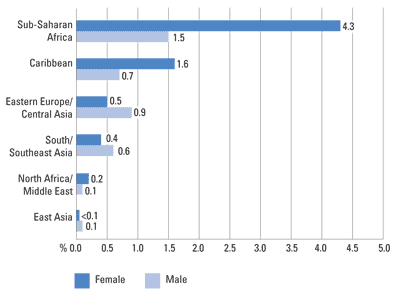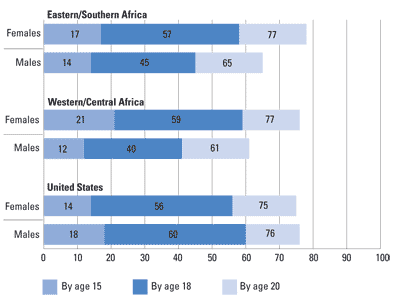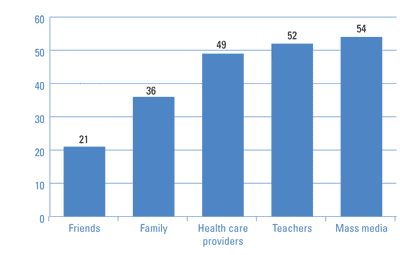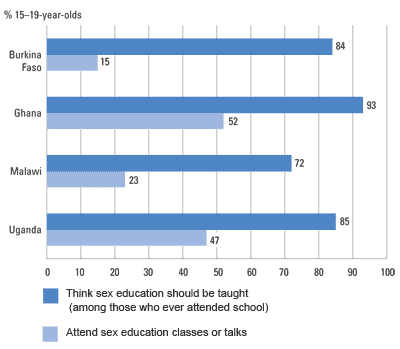The world in which teenagers are growing up today is very different from that of their parents’ and grandparents’ youth. Especially in developing countries, things are changing fast. Compared even with 20 years ago, young people are entering adolescence earlier and healthier, and they are likely to spend more time in school and enter the workforce later. As a result, marriage and childbearing now generally occur later than they did in the past, especially for women. And, inevitably, postponing marriage has meant that sex before marriage has become more common.
During this same period, HIV has spread rapidly throughout much of the world, particularly in developing nations, shattering lives and damaging the fabric of societies in the process. HIV affects men and women alike. Young women, however, face a dual challenge: In addition to the threat of AIDS, mortality and morbidity related to pregnancy, delivery and unsafe abortion remain among the most significant risks to young women health.
This article examines the vulnerability of young people to HIV and unintended pregnancy, and the choices adolescents make that have critical implications for their sexual and reproductive health.It draws on key findings of a forthcoming Guttmacher Institute report, Protecting the Next Generation: Preventing HIV and Unintended Pregnancy Among Adolescents in Sub-Saharan Africa. The report, and the larger study on which it is based (see box), focuses on adolescents' knowledge, attitudes and behaviors in four countries—Burkina Faso, Ghana, Malawi and Uganda. The evidence from these countries shows that teens are concerned about and want to protect themselves from both unplanned pregnancy and HIV, but that misinformation about sex and its consequences is common and many adolescents do not get the education and services they need. These findings have broad application, not only to youth in the four study countries or in Sub-Saharan Africa generally, but also to young people around the world. A major challenge for countries worldwide is to recognize that young people need support to successfully transition to adulthood and to forthrightly address the reality that, by the age of 18, most teens have begun to have sex. Unfortunately, many government programs—inspired by the United States' approach to teen pregnancy and HIV—have largely left adolescents on their own by focusing exclusively on abstinence for all unmarried individuals.
Reasons for Concern
The data are clear: Adolescents in Sub-Saharan Africa are concerned about preventing both HIV and unplanned pregnancy—and for good reason. Young people in Africa are much more likely to be living with HIV than adolescents in other regions around the world. Across Sub-Saharan Africa, HIV is spreading throughout the general population. Young women are more greatly affected than young men: An estimated 4.3% of women aged 15–24 in Sub-Saharan Africa are living with HIV, compared with 1.5% of men in that age-group (see chart). In some countries, the rates are much higher; 15% or more of young women in Botswana, South Africa, Swaziland and Zimbabwe are living with HIV. It is little wonder then that the Joint United Nations Programme on HIV/AIDS (UNAIDS) considers 15–24-year-olds to be the age-group "most threatened by AIDS" and "at the centre of HIV vulnerability."
| A CLEAR CRISIS |
|---|
| Young people in Sub-Saharan Africa are especially likely to be living with HIV. |
 |
| Source: UNAIDS, 2006. |
By far the predominant mode of HIV transmission in Sub-Saharan Africa is heterosexual intercourse, which also puts young women at risk of unplanned pregnancy. In Sub-Saharan Africa, the average birthrate is 143 per 1,000 women aged 15–19, well over twice the worldwide average of 65 per 1,000. Most births to teen mothers in Sub-Saharan Africa occur within marriage and are planned, but one in five teen pregnancies result in an unplanned birth. Across Africa, rates of unplanned births among teens vary widely, from a low of 11% in Niger to half or more of all adolescent births in Gabon, Ghana, Lesotho, Namibia, South Africa and Togo.
An unplanned pregnancy can be an emotionally wrenching experience for any woman, and it can be especially frightening for an unmarried adolescent, who may be unprepared to raise a child. In this circumstance, a young woman may seek to terminate her pregnancy. In most Sub-Saharan African countries, abortion is largely illegal. Nevertheless, it is common: An estimated 4.2 million abortions occur annually in Africa, more than a quarter of them among 15–19-year-olds. While some of these young women may be able to locate a trained provider and afford a safe procedure, the vast majority undergo clandestine procedures performed under crude conditions, endangering their health—and often their lives. Adolescents frequently make up a large proportion of patients who are hospitalized for complications from such procedures. In Malawi, Uganda and Zambia, hospital-based studies show that adolescent women represent one-fourth to one-third of patients suffering from complications, and in Kenya and Nigeria, more than half of women with the most severe abortion complications are adolescents. Each year, an estimated 12% of maternal deaths in Africa are attributable to unsafe abortion.
Preventing Pregnancies and HIV
The age at which teens in Sub-Saharan Africa typically initiate sex is surprisingly similar to that of teens in the United States and other developed countries. Although only a small proportion of teens have had sex by age 15, sexual experience is common by the late teen years. By their 20th birthday, roughly three in four young women and six in 10 young men in Sub-Saharan Africa have had intercourse (see chart). Adolescent sexual activity occurs both within and outside of marriage, with young women much more likely than young men to be married (see box). Premarital sex, however, is common, even among females. Indeed, in most Sub-Saharan countries, one-third or more of women have had premarital sex by age 18.
Most adolescents are aware that sexual activity puts them at risk of getting pregnant or contracting HIV. Their knowledge is not detailed, however, and myths are common. For example, many adolescents think that a young woman cannot get pregnant the first time she has sexual intercourse or if she has sex standing up. Some adolescents believe they can identify someone living with HIV by their outward physical appearance; others report that HIV can be transmitted through a mosquito bite or that a man who is HIV-positive can be cured by having sex with a virgin.
| SEXUAL EXPERIENCE |
|---|
| Like their U.S. peers, most 20–24-year-olds in Sub-Saharan Africa began having sex during their teenage years. |
 |
| Sources: National Research Council and Institute of Medicine, 2005, and Guttmacher Institute tabulations of the 2002 National Survey of Family Growth, 2007. |
Still, many sexually active teens take steps to protect themselves by using contraceptives, most commonly the male condom. Among sexually active women aged 15–19 in the four study countries, between 29% (in Malawi) and 47% (in Ghana) used a contraceptive method the last time they had sex. Contraceptive use among young men—almost all of whom were unmarried and substantial proportions of whom had two or more partners in the past year—was somewhat higher, ranging from 42% in Malawi to 55% in Uganda.
Information and Service Needs
In the quantitative surveys as well as the focus groups and in-depth interviews, adolescents in the study countries indicated that they want the information they receive about sex-related matters to be reliable and to come from trusted sources. For example, in Uganda, about half of all young people said, unprompted, that they would like to get information about contraceptive methods, HIV and other STIs from teachers, health care providers or the mass media, while just one-third said they preferred family and one-fifth preferred friends (see chart). When asked why they preferred the more formal sources, young people said they could be trusted to provide reliable information.
| WHAT TEENS WANT |
|---|
| Half of teens in Uganda say they want sexual health information from formal sources; fewer would prefer to rely on family or friends. |
| %12-19-year-olds |
 |
| Source: Guttmacher Institute, 2007. |
Given their desire for reliable information, adolescents in the study countries strongly support sex education in schools. At most, however, only half of young people get sex education in school, ranging from 15% in Burkina Faso to 52% in Ghana (see chart, page 6). Among those adolescents who report getting some sex education, the majority do so before they become sexually active. Half or more receive at least some information on a range of topics, including pregnancy and pregnancy prevention, STIs and abstinence.
| WANTED, NOT RECEIVED |
|---|
| The large majority of teens think it is important for sex education to be taught in schools, but far fewer end up receiving it because they do not attend school or sex education is not offered. |
 |
| Sources: Source: Guttmacher Institute, 2007. |
Adolescents in the focus countries say they would prefer clinics and hospitals over pharmacies and traditional healers as their sources for sexual and reproductive health care. Whatever their preferences, however, young people often do not go to clinics or hospitals for these services because they are embarrassed or too shy to seek them out, the cost of services is too high, or they do not know where to find a public clinic or hospital where they can obtain contraceptive methods or treatment for STIs.
Overarching Challenges
The challenges for policymakers and program planners seeking to address teen unintended pregnancy and slow the spread of HIV in Sub-Saharan Africa are daunting. Governments in Sub-Saharan African countries have made significant strides in recent years. Yet major hurdles remain, especially in two key, interrelated areas.
Fragile educational and health systems. Young people are spending more of their adolescence in school. Indeed, 60–75% of 10–14-year-olds in Sub-Saharan Africa are currently attending school. Moreover, for young people, school itself offers a certain level of protection. In Sub-Saharan Africa, levels of contraceptive use increase with years of education, and attendance in school is associated with less sexual activity.
Many adolescents—especially girls—however, never make it beyond primary school. Secondary school fees are one reason adolescents drop out of school, but many poor families cannot afford to send their children to school even when schools are free and available, because of the costs of uniforms, books and supplies, and transportation. Poor school quality—including a short school day, lack of trained teachers and large class sizes—is another reason many adolescents become discouraged and drop out of school.
In order to improve adolescent sexual health, more must be done to increase school attendance, especially among disadvantaged groups, as well as school quality. Recent studies have shown that programs that provide grants or subsidies to encourage parents to send their children to school can be highly effective at increasing enrollment and reducing dropout in some settings. Policymakers also need to invest in learning materials, infrastructural improvements and teacher training to ensure better learning outcomes and to keep young people in school.
Special attention needs to be paid to sex education. To be most effective, school-based sex education should reach adolescents before they begin to have sex. Because not all adolescents stay in school, sex education should begin in early primary grades. It should be age-appropriate, intensifying at the upper primary and early secondary school levels, and it should be mandatory. Finally, priority should be placed on improving the quality of sex education; teachers need quality materials and better training.
Meanwhile, the health services of many African countries have been badly undermined by decades of inadequate investment and by the burden of AIDS itself. Virtually everywhere, health care personnel are in short supply. And where personnel are available, many have not been trained to meet the needs of young people.
Strengthening the health care system to better serve adolescents requires taking a strategic look at ways to build capacity within the existing system, rather than creating a parallel structure focused only on adolescents. Health care providers need better training so they can use every contact they have with teens, regardless of the reason, as an opportunity to address adolescents' sexual and reproductive health needs. Clinics should provide youth-friendly services and sponsor outreach activities in surrounding communities and neighborhoods to reduce stigma and create safe and supportive environments. And policymakers should ensure that teens, regardless of age or marital status, have access to contraceptive services and to STI and HIV testing and prevention services on a confidential basis.
Finally, other important interventions to improve the sexual and reproductive health of young people may lie outside the health and education sectors. For example, because many adolescents use—and want—sexual health information from the radio and other media sources, support for quality programming, better training for journalists in health care reporting and media expansion into rural areas need to be high priorities, along with improvements in schooling and health care. In other words, the evidence suggests that a combination of strategies is more effective than any single strategy in improving adolescents' sexual and reproductive health, and countries should use a variety of approaches.
Social and cultural issues. Closely related to these structural issues, a second overarching challenge is a set of social and cultural beliefs that impede young people access to the information and services they need to protect themselves. Adolescents say that fear and embarrassment constitute the greatest barriers to their seeking information and services. In many societies, sexual activity among young people prior to marriage remains stigmatized, and even talking about sex is taboo. Because policymakers do not want to be perceived as promoting promiscuity, they may be reluctant to expand the capacity of teachers and health care providers to effectively provide sexual health information and services to young people. This is a serious mistake. Failure to acknowledge the central role that sexuality plays in the lives of virtually all people, and that sexual experimentation plays in the lives of young people, is self-defeating.
All of this is made worse by persistent gender inequalities. Young women general lack of autonomy translates into a disproportionate inability to control their sexual experiences, which in turn only increases their risk of unplanned pregnancy and HIV.
Protecting the Next Generation
Around the world, policymakers, parents, teachers, health care providers and others who come in contact with youth are grappling with the implications of adolescent sexual activity. An individual country approach and policy responses are, of course, reflective of its broader social, cultural and economic conditions. Developing countries' actions are also shaped by foreign aid. A range of policy and program interventions is being promoted worldwide, but major donor countries cluster around two fundamental and sharply contrasting approaches.
One approach is to promote abstinence as the only acceptable behavior for people who are not married. Although not exclusive to the United States, abstinence-only-until-marriage education is the cornerstone of the Bush administration approach to reducing teen pregnancy and HIV. The U.S. government has spent well over $1 billion to promote premarital abstinence among its own citizens, through highly restrictive programs that ignore or denigrate the effectiveness of contraceptives and safer-sex behaviors.
The United States is exporting its approach to adolescent sexuality overseas through its foreign assistance, specifically through the President Emergency Plan for AIDS Relief (PEPFAR). PEPFAR strategy for HIV prevention is the so-called ABC approach—Abstain, Be faithful and use Condoms—which, according to the U.S. guidance, employs "population-specific interventions that emphasize abstinence for youth and other unmarried persons, including delay of sexual debut; mutual faithfulness and partner reduction for sexually active adults; and correct and consistent use of condoms by those whose behavior places them at risk for transmitting or becoming infected with HIV." Accordingly, recipients of U.S. HIV funds may provide teens aged 15 and older with information about condoms, but cannot use these funds to "promote or provide" condoms to youth; teens younger than 15 cannot receive even information about condoms. The U.S. guidance contends that providing adolescents with information about both abstinence and contraception sends a "confusing" and "conflicting message" that "appear[s] to encourage sexual activity"—despite clear evidence to the contrary.
Contrast this approach to that of many Western European countries. For example, in Great Britain, the Netherlands, France and Sweden, adolescent sexual expression is largely taken for granted. The focus of sex education in these countries is not abstinence but the provision of comprehensive information about the biological and emotional aspects of sexual development, relationships, decision-making skills, communication and negotiation. Information about the benefits of contraception and the importance of con-traceptive use among people who are sexually active and not seeking a pregnancy is standard. Governments in these countries support consistent and long-term public education to prevent teen pregnancy and HIV, and many provide contraceptives free of charge to adolescents. Positive acceptance of adolescent sexual expression is by no means value-free, however. The general expectation is that sexual intercourse will take place within a committed relationship, and those who are having sex will protect themselves and their partners from unintended pregnancies and HIV. It is assumed young people will make well-considered and responsible decisions if they have access to information and health services.
Indeed, just as the United States exports its basic approach to teenagers and sex, the approach taken in Western Europe is reflected in the countries' foreign aid programs. For example, in contrast to the ABC approach, the Dutch government is promoting what it calls its "RAP rule" overseas—sexual and reproductive Rights, Acceptance of young people's sexuality and Participation of target groups in all phases of programs. The Dutch government is unapologetic in supporting programs that promote a positive attitude and comprehensive approach toward the sexual and reproductive health and rights of young people.
Up to now, the United States has played a major role in development assistance as the single largest donor in the fight against AIDS, and, sadly, PEPFAR's emphasis on abstinence—including the requirement that at least one-third of all U.S. assistance to prevent HIV globally be reserved for "abstinence-until-marriage programs"—has limited young people's access to sexual health information and services. PEPFAR is up for renewal in 2008, but whether the United States is poised to lift its restrictions on funding remains to be seen. Meanwhile, donors and recipient countries worldwide would be wise to take a lesson from Western Europe. In these countries, where there is a basic acceptance of teen sexual behavior, contraceptive use among those who are sexually active is widespread and levels of adolescent pregnancy, childbearing and abortion are remarkably low. The adolescent pregnancy rate in the United States, for example, is nearly twice that in Great Britain and approximately four times that in France and Sweden.
The Guttmacher study shows that while many young people are taking steps to protect themselves, they clearly want and need help in managing their sexual and reproductive health. Only by listening to adolescents and understanding the specific barriers they face will we be able to give them the guidance and support they need so they can be responsible in their own lives, contributors to society and sources of strength as the next generation.
About This Article
This article, also produced as a Guttmacher Institute In Brief, summarizes key findings of a multiyear, multicountry study on the scope of young people’s sexual and reproductive health needs in Sub-Saharan Africa. Guttmacher staff worked with 10 organizations (nine based in Africa) to gather evidence in four Sub-Saharan African countries—Burkina Faso, Ghana, Malawi and Uganda—where national surveys of 12–19-year-olds, focus groups of 14–19-year-olds, in-depth interviews with 12–19-year-olds and in-depth interviews with key adults in adolescents’ lives were conducted. The Guttmacher study complements a robust body of evidence on adolescents globally published in the past five years by, among others, the National Research Council, the World Bank and the World Health Organization. It is unique, however, in that it presents information gathered from adolescents themselves and that it addresses, in an integrated fashion, young people’s risk of both HIV and unplanned pregnancy. This article was supported by a grant from the Bill & Melinda Gates Foundation, the Rockefeller Foundation and the National Institute of Child Health and Human Development (grant 5 R24 HD043610). The conclusions and opinions expressed here, however, are those of the author and the Guttmacher Institute.
Young Women Within Marriage
While women in Sub-Saharan Africa are now less likely to be married in their teenage years than they were in the past, a substantial proportion of women still marry at a young age. Although rates vary considerably from country to country, roughly four in 10 women in Sub-Saharan Africa marry before turning 18 and six in 10 women do so by age 20. In contrast, slightly more than one in 10 men in Sub-Saharan Africa marry before turning 20.
A Sub-Saharan African woman who marries at a young age is likely to marry a man who is older than she is. She will often have her first child within a few years of getting married, in part because childbearing may be one way a young woman seeks to ensure the stability of her marriage and acquire status in her community. With motherhood the primary focus of her life, she may leave school and may have limited control over her daily activities. Moreover, she may be highly vulnerable to coercion and sexual violence—and to contracting HIV or other STIs—because she lacks individual autonomy and power, as well as information, education and access to services.
Women who marry in their early teenage years are at an even greater disadvantage, lacking the experience, skills and sense of self that even a slightly older woman may be able to bring to her marriage and family. Moreover, pregnancy and childbearing at a young age—when a woman is still developing physically—pose serious health risks for a young woman and for her infant, contributing to high levels of maternal and infant deaths and complications.
If a woman delays her marriage—even for a few years—she may be able to pursue her education further and obtain skills that increase her access to employment, health care and other resources. Experts agree that formal education for adolescent women is key to delaying marriage and to addressing the poverty, low status and social norms that drive the marriage timing decision. For those young women who are already married, it is important to recognize that contrary to what some may think, marriage does not protect women from HIV or unplanned pregnancy. To plan the children they want to have and to safeguard their health, married adolescents must have access to comprehensive reproductive health services that take into account their age and the age of their spouse, power differentials, social networks, negotiation skills and social norms around childbearing.
